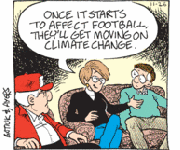Cross-posted from ThinkProgress Green.
This Saturday’s Crankshaft cartoon took on global warming, noting that climate change is threatening Ohio’s iconic buckeye trees, the namesake of the Ohio State Buckeyes. “Once it starts to affect football, they’ll get moving on climate change,” one character says:
As greenhouse pollution from oil and coal continues to build, the Ohio buckeye (Aesculus glabra) is on its way out of the Buckeye State. Between 1990 and 2006, United States hardiness zones shifted northward, putting Ohio closer to the southern end of buckeye viability. That trend will accelerate. A 2007 study by Daniel W. McKenney and other forest scientists of the effect of climate pollution increases on 130 tree species projects major changes in North American tree populations [PDF], as practically all of the southern and western United States grow too warm and arid for nearly all species. The Ohio buckeye’s range, now centered on Ohio and Indiana, is projected to shrink and shift drastically under business-as-usual scenarios:
Ohio buckeye range, 1971-2000 (Green marks the core range)
Ohio buckeye range, 2071-2100
Importantly, the destruction of the Ohio buckeye’s traditional range is not just a long-term phenomenon. Several of the scenarios modeled by the researchers find major shifts during the 2011-2040 period.
A simpler 2005 study that modeled the expected shift in range over 100 years due to a doubling of carbon dioxide concentrations found that the Ohio buckeye range would decline [PDF] by 12 to 51 percent this century. At current rates, carbon dioxide concentrations are on track to quadruple.




